The best dash cam

By Rik Paul and Molly K. McLaughlin
This post was done in partnership with Wirecutter. When readers choose to buy Wirecutter's independently chosen editorial picks, Wirecutter and Engadget may earn affiliate commission. Read the full guide to dash cams.
Wham! A car crash can happen in an instant. And as frightening as that may be, it can be just as distressing to be blamed for a crash that's not your fault. That's why a dash cam can be a critical aid if the unexpected happens. After researching more than 250 models and testing about 40, we've found that the best overall dash cam is the Nextbase 522GW. It delivers the sharpest video we've seen, is the easiest to use, and has handy features that you don't get with most other dash cams.
The Nextbase 522GW Dash Cam produces a super-sharp 1440p (or Quad HD) video image that in our tests allowed us to clearly see details that were indecipherable with most other dash cams. Using the 522GW's bright, responsive touchscreen to navigate menus and adjust settings is much easier than fiddling with the buttons of other models. With its powered magnetic mount, the unit is easy to snap on and off, without having to mess with a cord. The Nextbase phone app outshines competitors', and in addition to GPS, Bluetooth, and Wi-Fi, the 522GW gives you a polarizing filter to minimize annoying reflections. The camera can integrate with Amazon's Alexa digital assistant, and a new Emergency SOS feature automatically summons emergency aid after a crash. The 522GW can also pair with three different rear cams, giving you more versatility. Yes, it's more expensive than many competing models, but it provides the best dash-cam experience of any model we've tested.
If you can't get the 522GW, or just want a slightly smaller model, we recommend the Nextbase 422GW. It gives you the same excellent video image and most of the same features, but it's more compact, with a smaller touchscreen display (2.5 versus 3 inches). It also usually costs less, and it lacks only the polarizing filter (although you can add an an optional one).
If you want to record incidents behind your vehicle as well as in front of it, we recommend that you use a dual-cam model, which includes a second camera that's mounted to the rear window. The best overall package would be to add Nextbase's optional rear camera to either the 522GW or the 422GW, but those combos can get pricey. For about half the price, or less, you can get the Papago GoSafe S810. Its front camera is surprisingly sharp for a 1080p model, and the video image has good color and contrast, as well as a decent dynamic range at night. As with most dual-cam models, the rear camera's image quality isn't as good as that of the front camera—it's less sharp, with duller colors and more contrast.
If you want to record the interior of your car as you drive, we recommend the Vantrue N2 Pro, which has a camera that records the view in front of the car and another one that faces the interior, a handy setup for ride-for-hire drivers who want to document their passengers. The front camera—recording in 1080p resolution—provides good overall image quality, although it's not as sharp as that of our single-cam picks. And the rear-facing camera lets you see all passengers, even in total darkness.
If you prefer a dash cam that people likely won't notice, we recommend the Garmin Dash Cam Mini, which is one of the smallest and most discreet models we've tested. About the size of a key fob, the Mini virtually disappears on the windshield. Still, it provides surprisingly good video quality for a 1080p model, and it's easy to pop on and off of its adhesive mount. Because the Mini has only two physical buttons and no display, though, you have to use Garmin's smartphone app to view video, to adjust settings, and even just to aim the camera properly.
We've had no heat-related problems with a couple of Nextbase models we used during several sizzling summer months in Southern California and New York. But if you want extra insurance for hot and cold conditions, we recommend the Vantrue T2. Instead of a lithium battery (used in most dash cams), the T2 uses a capacitor power supply, which holds up better in extreme temperatures. This gives the T2 the widest operating-temperature range (-4 to 158 degrees Fahrenheit) of any affordable model we've tested. (The Blackvue DR900S-1CH 4K provides the same temperature range, as well as better video quality, but it costs about twice as much.) The T2 also has a more sophisticated parking-mode system than most models, for recording incidents that happen when the car is parked. But this model's 1080p video isn't as sharp as that of the Nextbase 522GW or the 422GW, and the T2 isn't as easy to use.
In our tests, we found the Owlcam to be the best dash cam for monitoring your vehicle around the clock, including when it's parked. This model has the usual front-facing camera as well as a second one for the vehicle's interior, to document impacts from other cars as well as break-ins. If something happens, you get an alert on your phone, and the camera automatically records and uploads video, which you can view on the app (or watch live at any time). But the Owlcam is more expensive than our other picks, and even though you get a year of free access to the company's 4G LTE service (needed for the remote access features), it costs about $10 per month after that.
Why you should trust us
Rik Paul, who conducted our latest tests, is Wirecutter's autos editor and was previously the automotive editor for Consumer Reports and the senior feature editor for Motor Trend. He has been testing and writing about automotive electronics and accessories for the past 25 years. To get the legal perspective on dash cams, he interviewed Ben Schwartz, a personal injury attorney and managing partner of Schwartz & Schwartz Attorneys at Law.
Molly McLaughlin, who wrote a previous update for this guide, has written about consumer electronics and software for PCMag, Lifewire, DealNews, and many others, and was a senior editor at ConsumerSearch, a reviews website.
Who should get this
If your routine drive ever turns into a life-altering event, you'll probably appreciate having a dash cam to show what happened. This continuously recording, windshield-mounted device can document an accident you're involved in and provide you with evidence to share with a lawyer, an insurance company, or law enforcement, helping you prove something wasn't your fault (ideally) rather than leaving you to hope everyone takes your word for it.
Case in point: A Wirecutter staffer was able to use his dash-cam footage to prove that he wasn't at fault after he was rear-ended in a parking garage. Although the forward-facing camera couldn't record the vehicle in back actually striking his car, he said that "it showed that I was driving appropriately, and captured the sound, jolt from impact, and mine and my girlfriend's reactions."
In addition, a dash cam can help other drivers who need objective eyewitness evidence following a crash, a hit-and-run incident, or a road-rage incident. You can use it to record unsafe roadway conditions or to monitor the driving habits of someone else, such as a young, inexperienced driver or an aging senior (with their consent, of course). And a dash cam can also come in handy if you want to capture and share a funny scene, a memorable trip moment, a beautiful vista, or unusual happenings—like streaking meteors.
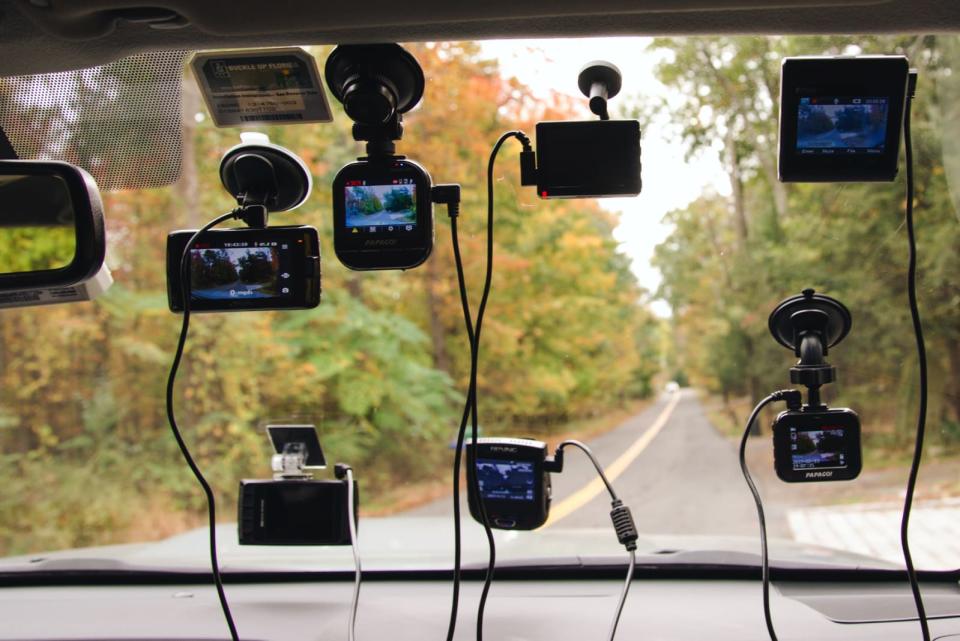
"There are thousands of people who are injured and killed every year by hit-and-run drivers," said Ben Schwartz, a personal-injury attorney we interviewed. "If those hit-and-run victims had a dashcam in their car, maybe the video would record the tag number of the vehicle that hit them, and then that would lead police to the bad guys."
But there are potential disadvantages, Schwartz noted. "Not only will a dash cam document other people's mistakes, but it's going to document yours." Whether or not you think you're at fault, Schwartz said, you should first show the footage to your lawyer. "Let the attorney determine whether the footage is favorable or not favorable to [your] case, and let the attorney advise you on what to do with the footage."
Finally, there are some practical considerations. Learn how to set up a dash cam, and start thinking about how you'd connect a dash cam in your own car (be sure you have a convenient enough power supply) before deciding that you want one. Almost all dash cams record video on a removable microSD card, and many don't come with one, so this could be a separate purchase. A good microSD card (like the ones we recommend) costs about $20 or less at this writing. Also, you should confirm that you can legally mount a dash cam on your windshield where you live, and learn your state's rules for recording audio conversations.
How we picked
Before choosing which dash cams to test, we spent hours researching the specs and features of about 250 models, and we read reviews from TechRadar, Digital Trends, BlackBoxMyCar, T3, Autoblog, and PCMag (many of them were thin on hands-on experience). We checked owner reviews and ratings, perused some driving laws and insurance claims, and watched hours of people's dash-cam footage.
Most dash cams work in a similar way. They record to a microSD card and use loop recording, so the oldest video is overwritten by the newest. They have built-in G-sensors (or accelerometers), which detect an impact, and if a crash occurs, the device will automatically save that footage from being overwritten. Typically, you can also manually save footage by pressing a button or giving a voice command. You can review footage on the unit's display, on a smartphone app, or on a device that can read a microSD card. Dash cams can also record audio, if you want, and most models let you capture a still photo.
A model's price is not a surefire gauge of its quality, but we have found that the cheapest dash cams (typically those under $100) can't compete with higher-priced ones in that regard. We're reluctant to recommend the cheaper ones because we believe they might let you down when you really need a high-quality video recording.
Even though we also consider a model's owner ratings, we've found they're not something you can rely on. A large number of dash cams that have high ratings on Amazon, for example, get low grades—such as a D or an F—on Fakespot. This doesn't reflect on the quality of the dash cam, only on how reliable the rating is.
Those standard considerations aside, we also looked for models that had the following features.
The most important features
Image quality: A dash cam's video—whether captured in light or dark conditions—has to be sharp and distinct enough that you, a lawyer, your insurance company, or a member of law enforcement can read license plates and see other details clearly. We lean toward testing the latest higher-resolution models, with 1296p or higher resolution, because they are often notably sharper than 1080p models. We wouldn't consider buying any dash cam that has only 720p resolution.

Controls: We looked for models with clearly labeled, easily reachable controls (especially the video-lock button). We also preferred models that had buttons we could identify in the dark, intuitive menus, and a functional companion app. Models with touchscreens are typically the easiest to use.
Mounting system: We looked for mounts that held the camera securely yet let us easily aim it, as well as easily remove it. We've found magnetic mounts to be the easiest to use. Mounts that attach to the windshield with adhesive pads are often more compact and very secure, but they can be difficult to remove for repositioning or swapping between vehicles. Suction-cup mounts work well for that. Many models give you a choice between mount types.

Display: Most dash cams have a display that's 1½ to 3½ inches measured diagonally; displays that are at least 2 inches make it easier for you to adjust settings on the fly and preview footage. Models without a display require a phone or computer to view video footage and set up the camera—generally not our preference.
Size: Smaller dash cams are more discreet, but larger ones can be easier to use because of their bigger displays and buttons. We've found that moderately sized dash cams provide a good balance.
Field of view (FOV): We preferred models with an FOV in the range of 140 to 160 degrees—wide enough to take in a multi-lane highway or large intersection without creating a wide-angle effect that makes cars in front look farther away and details harder to see.

Important for some people
Wi-Fi and smartphone app: We like an integrated Wi-Fi network because it allows the dash cam to connect to a compatible smartphone app, through which you can view, download, or share video. The best apps also have a map that shows the car's location, speed, and other details.
GPS receiver: A GPS receiver lets a dash cam record a car's location, the trip history, and the speed and direction of travel—all valuable information for figuring out how an incident occurred. The best models have the receiver integrated into the mount, rather than needing a separate plug-in device. (A dash cam's GPS receiver doesn't provide turn-by-turn directions; you could use a smartphone mapping app or a dedicated car GPS navigator for that.)
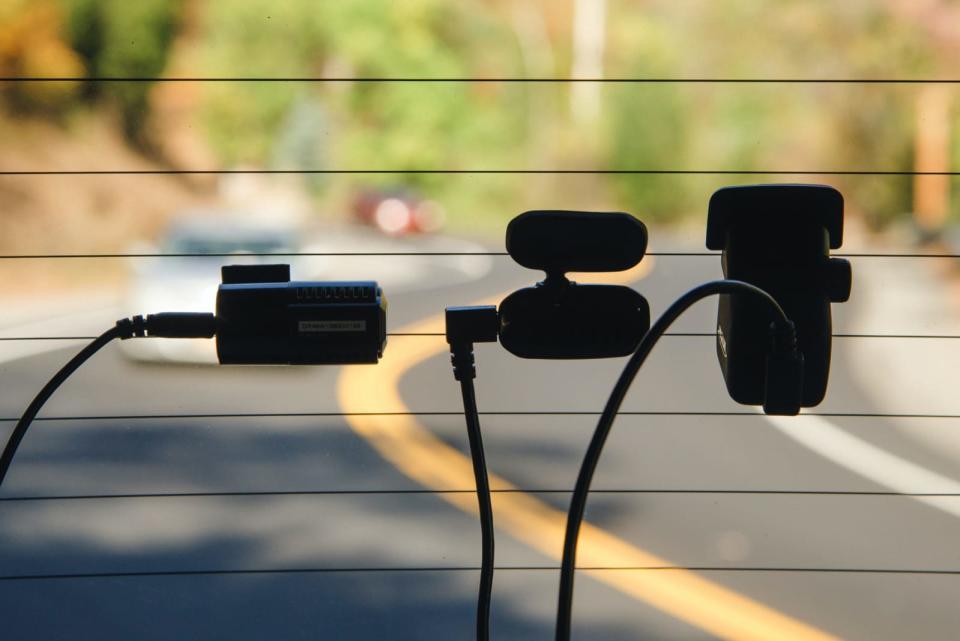
Dual cams: To record video of what's behind (or inside) your vehicle as well as in front, a dual-cam model includes a second camera: either a small, separate camera that you mount to the car's rear window or a second lens that points toward the car's cabin and passengers. We dismiss any of the latter models that can't capture video in a dark interior.
Parking surveillance: Most dash cams provide a parking mode (which records impacts or movement around your parked car), but they're usually limited by the device's field of view or power supply. To provide power when the car is off, a dash cam usually needs to be hardwired to the car's fuse box, connected to an external battery, or plugged into the vehicle's OBD-II diagnostic port.
Driver-assist features: Basic driver-assistance and safety alerts can include forward-collision warnings, which sound an alert if you are following too closely; lane-departure warnings, which let you know if your car is crossing a lane marker on the road; and other features such as stop-sign recognition, reminders to turn on your headlights, and driver-fatigue reminders.
Capacitor power supply: For power, some dash cams use a capacitor (instead of a lithium-ion battery), which handles extreme temperatures better. Though we haven't had temperature-related problems with any of our lithium-ion-powered picks—even during summer heat waves in Southern California—at the request of readers, we've added a pick with a capacitor.
Customer service: We want our readers to be able to easily contact a dash cam's manufacturer, if needed, so we typically haven't tested models from companies that don't provide a US address or phone number. That said, some readers have let us know that, despite the absence of this information, they've received good customer service from such veteran dash-cam brands as Viofo and Street Guardian.
How we tested
While setting up each dash cam, we first evaluated the layout of the controls, the size and location of the buttons, and how easy it was to navigate the menus. We checked the brightness and clarity of the display, connected it to its app (if applicable), and performed common tasks, and we took notes on the camera's build quality and overall design. We then set up the dash cams in a test car, evaluating how easy it was to attach the mounts to the windshield, connect the dash cams to their mounts, adjust the aim of the cameras, and then remove them. We tested the cameras in bright sunlight and at night, and on highways and suburban streets, racking up hours of driving time. To make sure we could accurately compare the dash cams to one another, we drove the same routes, which we chose for the amount of detail available for the cameras to capture. Then we spent many more hours playing back the video footage on a computer so that we could examine and compare details and overall image quality. Based on all of this, we finally made our picks.
Our pick: Nextbase 522GW Dash Cam
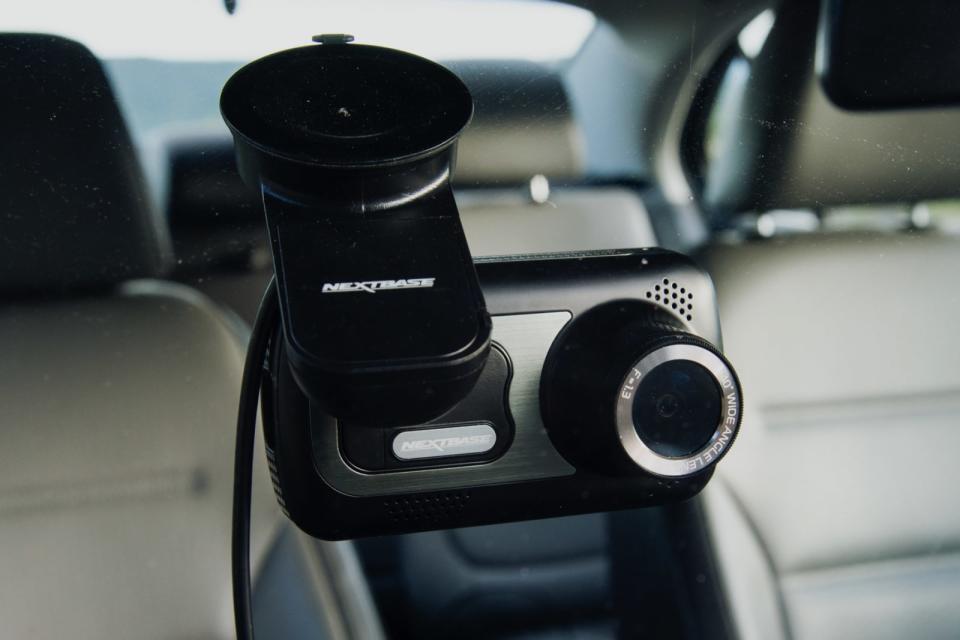
Overall, the Nextbase 522GW delivers more of the things we look for in a dash cam than any other model we've tested. It provided the sharpest, clearest video we've seen, even compared with higher-priced models. It's the easiest to use, thanks to a number of handy features that most other models lack. Any of three different rear cameras can couple with the 522GW, giving this camera more versatility than other brands' models. And the 522GW includes a new, Emergency SOS feature, which can automatically notify emergency personnel after a crash.
The 522GW records at 1440p resolution, with a good 140-degree field of view. In our testing, license plates and details of cars in front of us were crisper and clearer than we what we saw using other dash cams. And when we were driving down the main street of a nearby town, with the 522GW we could easily read the license plates of parked cars and even cars passing in the opposite lane. Those details were less clear with other high-performing models, and they were indecipherable with most other dash cams. All of this means that the 522GW is more likely to capture the details you need if an unexpected incident occurs.

In addition, the 522GW's video has bright colors and evenly balanced tones, and the camera adjusts quickly when you're driving from bright sun into shade or vice versa. This camera's night video, a weak point with many cams, is also impressive. We saw good shadow detail and minimal glare, and license plates were very legible, so it was generally easy to see what was happening.
Although most dash cams have only small physical buttons for navigating menus and adjusting settings, the 522GW has a relatively large, 3-inch touchscreen that's clear, bright, and responsive, so accessing these functions is quicker and more intuitive. And the 522GW makes it easy to view video without having to use a phone app or computer. An ambient light sensor dims the screen automatically in low light—a nice touch that we didn't find in any other models. There's also a single, easy-to-reach button below the display so you can manually lock a video to prevent it from being overwritten. You can also take a still photo by tapping the touchscreen.
A GPS sensor is integrated into the mount (this is a separate add-on for many dash cams), and the 522GW includes Bluetooth and Wi-Fi for connecting to a compatible phone app. This is also one of the few dash cams we've tested that come with a polarizing filter, which helps to minimize annoying reflections on the windshield.
The 522GW's thoughtfully designed magnetic mount is another of its high points. Because the cord can plug directly into the mount, you can easily snap the dash cam on and pull it off without having to mess with the cord, which you have to do with most models. This makes the 522GW very easy to take with you and reinstall when needed. This model also gives you the option of using an adhesive or a suction-type mount; the adhesive is more compact, but the suction mount held firm throughout our spring and summer testing.
The 522GW connects to Nextbase's phone app (available at both the App Store and Google Play) through an internal Wi-Fi network, letting you see a live view and recorded videos, download video to a phone, or adjust settings. As you play back video, the program shows you a map with the car's location, as well as the vehicle's speed (real-time, average, and maximum for that video segment), GPS coordinates, direction of travel, and even the unit's G-sensor readings, which can help prove how forceful a crash is and pinpoint the exact moment it occurred. A new AutoSync feature will also automatically send video files to a driver's smartphone following an incident. No other dash-cam app provides such a variety of tools.

An Emergency SOS function is a new connected feature; if a crash is detected and the phone remains still or goes unanswered, the 522GW will automatically notify emergency services (through Northern911) and direct them to the car's GPS coordinates. You can also enter limited personal and medical information into the app, and it will be automatically sent to the emergency personnel to help them prepare.
The 522GW also gives you access to Amazon's Alexa digital assistant, as long as you have the Alexa app on your phone. Since Alexa's audio comes through the phone, though, we're not sure of the value of having the 522GW be a middleman between you and Alexa. In our testing, this function also didn't work reliably every time. The main benefit will arise when Nextbase's upcoming Alexa skill is introduced (it's expected this fall); it will let you use basic voice commands to start or stop recording, protect a video, take a still photo, and so on.
The 522GW can pair with three different rear cams, giving you even more versatility. A conventional rear camera, connected by a cord and mounted to the rear window, provided very good video, with good color, excellent dynamic range, and crisp detail, even at night. The other two are plug-in modules, which we found to be of limited use. One has a moderate telephoto lens, which gives you a similar view to your rearview mirror. This worked well enough, but in our VW Jetta sedan test vehicle, the car's rear headrests blocked much of the view, and it was hard to see much detail when a car was close behind. The second module has a wide-angle lens for recording a car's interior. This worked well when there was sufficient ambient light, but it recorded only blackness when there wasn't. We also wished for a slightly wider-angle lens, to cover more of the interior.
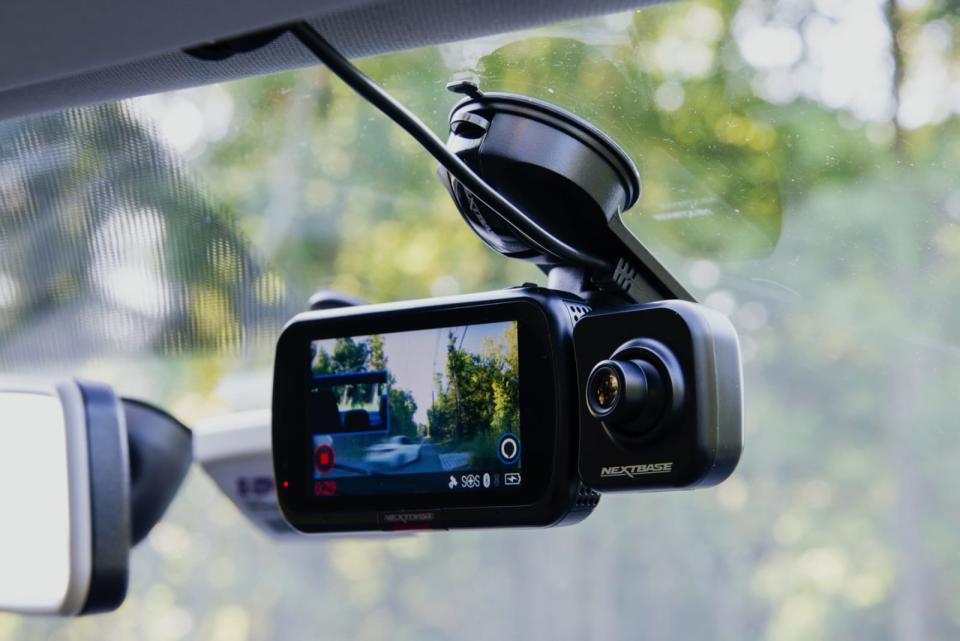
The 522GW also has a parking mode, which monitors the car while it's parked with the engine off. If the dash cam's G-sensor detects a bump or other physical movement, the unit will turn on and record for three minutes. We didn't test this function, but unless the event is in front of the car, or you have a rear camera connected, the video could be of limited use. If 24-hour monitoring is a top priority, we recommend the Owlcam instead.
Finally, it's also worth noting that the 522GW's premium styling—with a high-quality, matte-black plastic body and brushed aluminum trim—would fit in well in even a luxury car. The 522GW does cost more than most dash cams we've tested, but if your budget will allow, it will give you the best experience of any model we've tried.
Flaws but not dealbreakers
The 522GW's dimensions (about 3 inches wide by 2 inches high) provide the space for its clear, 3-inch touchscreen, but we wouldn't call the unit "stealthy." If you prefer a less-noticeable dash cam, the slightly smaller Nextbase 422GW and the tiny Garmin Mini might be better choices.
We've had no heat-related problems with Nextbase models while using them for months at a time in Los Angeles and New York—including during extended heat waves. But the model's specs claim an operating-temperature range of -4 to 113 degrees Fahrenheit, which is a lower maximum temperature than that of our other picks or many other models. If high heat is a primary concern for you, the capacitor-powered Vantrue T2 might be a better choice.
Runner-up: Nextbase 422GW Dash Cam
The Nextbase 422GW Dash Cam offers most of the advantages of the 522GW, its bigger sibling, but in a smaller, usually lower-priced package. It gives you the same super-sharp, 1440p resolution and bright, clear image quality. And it has the same easy-to-use magnetic mount (adhesive or suction), so the unit is simple to pop on and off the windshield. The 422GW also uses the same handy smartphone app and computer software as the 522GW. In fact, the only feature it doesn't share with the 522GW is a polarizing filter (although you can add an optional one).
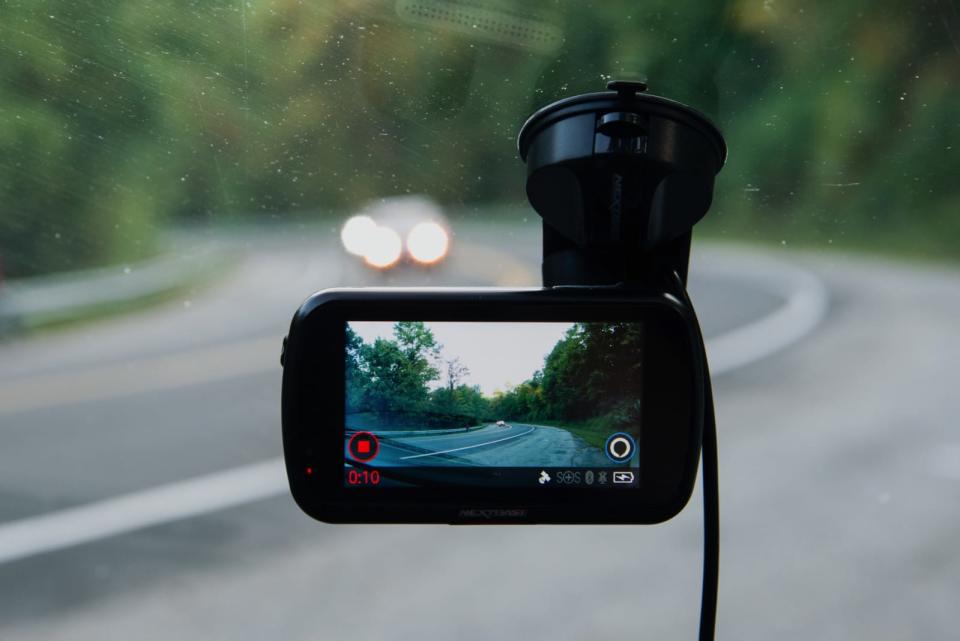
The 422GW is a little more compact than the 522GW, measuring about ½ inch smaller in width and ¼ inch shorter in height. So you could easily fit the 422GW in a pocket or a bag after you've removed it from the car. This also means it has a smaller, 2½-inch touchscreen that—even though it's just as bright and clear as the 522GW's screen—makes it a little harder to see details in images.
Also great: Papago GoSafe S810
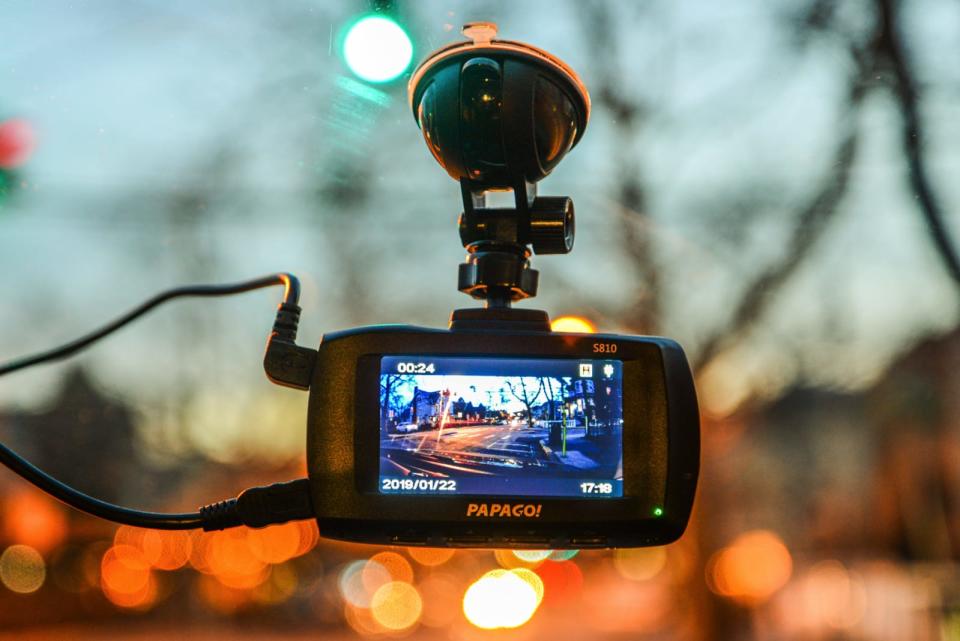
For a dual-cam model that can record behind your vehicle as well as in front of it, we think the Papago GoSafe S810 Dash Camera is the best option. In addition to its front camera, the S810 comes with a small camera that you mount to the car's rear window. The best overall dual-cam package, in terms of video quality and ease of use, would be to buy the Nextbase 522GW or 422GW and add on Nextbase's optional rear-window camera. But that combo could cost twice as much as the S810.
As with most other dual-cam models we tested, the S810 records at 1080p resolution. It provides good detail, contrast, and decent dynamic range at night but isn't as sharp as our single-cam picks. Its field of view is a reasonable 140 degrees. The rear camera, compared with the front, produces usable footage, but it records at a more narrow 120-degree FOV and has a duller overall image with less sharpness and more contrast at night.
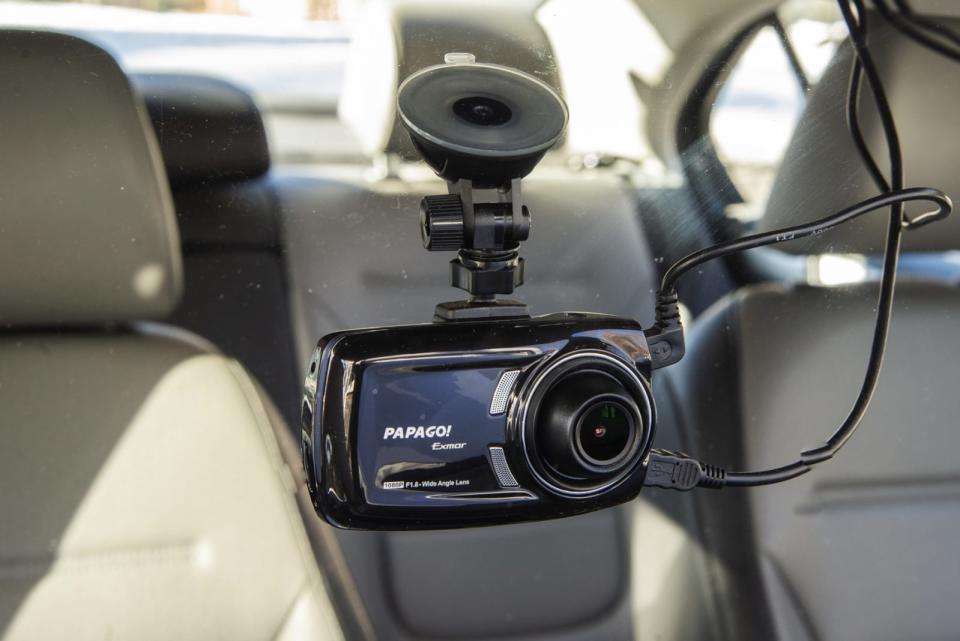
The S810 is an average size for a dash cam, and it has a bright, clear 2.4-inch screen, as well as easily navigable menus, a versatile mount, and a convenient video-lock button. The suction mount sticks well (an adhesive one is also included), and a large locking knob makes it easy to tighten the cam on the mount. Four buttons sit on its underside; they're hard to see at night but easy to access by touch.
Here are samples of test video from the Papago GoSafe S810, recorded in day and night conditions.
The S810 doesn't come with a GPS receiver, but you can connect an optional one if you want. Like several of the dual-cam models we tested, this model doesn't offer Wi-Fi or a compatible smartphone app. To be honest, it's not as strong a performer as our other picks, but there are far fewer dual-cam options available, and this is the best moderately priced choice we've found. Like other Papago models, it provides a number of driver-assist features, including stop-sign recognition, departure-delay, a headlight reminder, and a driver-fatigue alert.
Also great: Vantrue N2 Pro
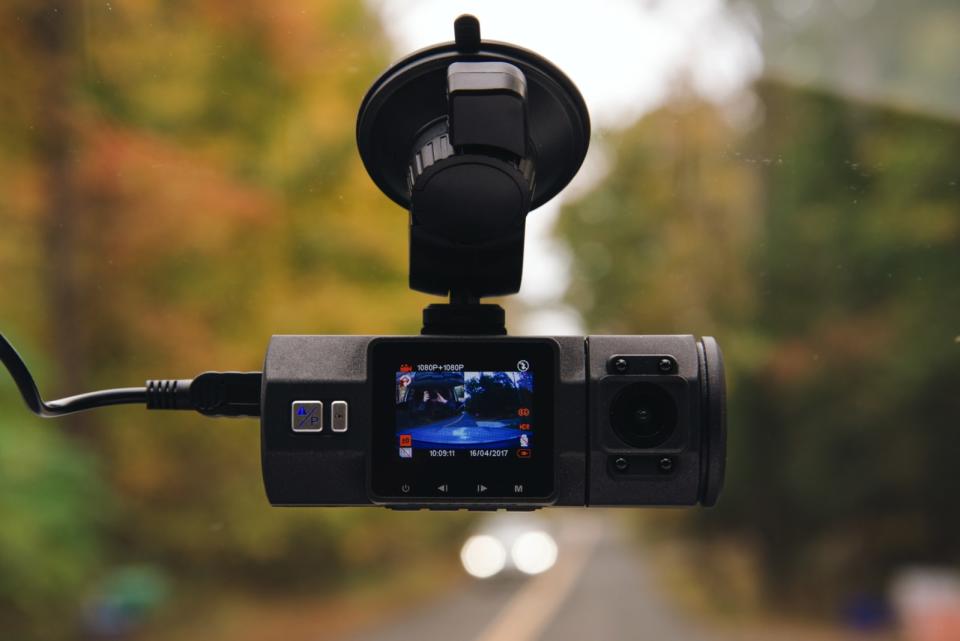
The Vantrue N2 Pro has two cameras: one pointed forward and the other aimed at the vehicle's interior. The rear cam's 140-degree field of view lets you easily see people in the front and rear seats from door to door. But among other compromises, its road-facing image quality isn't as good as that of our other picks, so we recommend this only if your priority is recording passengers.
Key to the N2 Pro's superior performance are four infrared LEDs surrounding the rear camera lens that, when activated, let you see people in the vehicle even in total darkness. By contrast, the video captured by similar models without LEDs was completely black when there was no ambient light around the car. The LEDs deliver a grayscale image rather than a color one, but that's a minor nitpick.
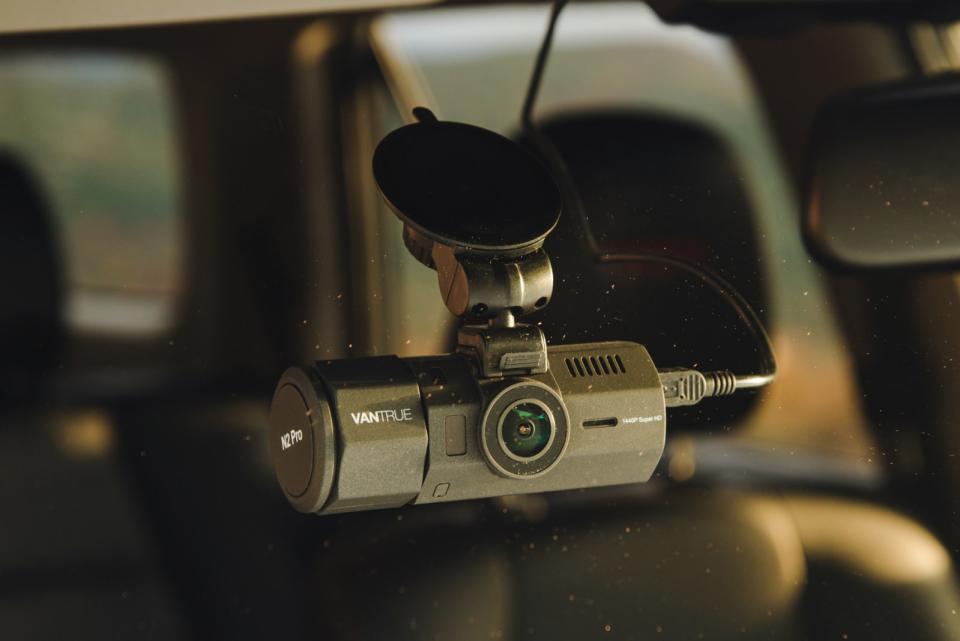
The N2 Pro's front camera records at 1080p resolution, which produces usable images with good color and contrast. At night, the video lacks sharpness, and any glare can obscure license plates and other details. The front cam's 170-degree field of view is wider than that of our other picks, but it makes cars in front look farther away. If you don't need the rear cam, the front camera can record at 1440p.
The N2 Pro easily slips on and off its suction mount, which allows for a wide range of adjustment for the front cam. The rear cam rotates vertically within the housing but not side to side. This wasn't a problem in recording the area we wanted.
The N2 Pro's long, angular shape doesn't draw attention to itself on the windshield, but its 1½-inch display was one of the smallest in our tests, and the unit's tiny buttons aren't as easy to use as those on our other picks.
Also great: Garmin Dash Cam Mini
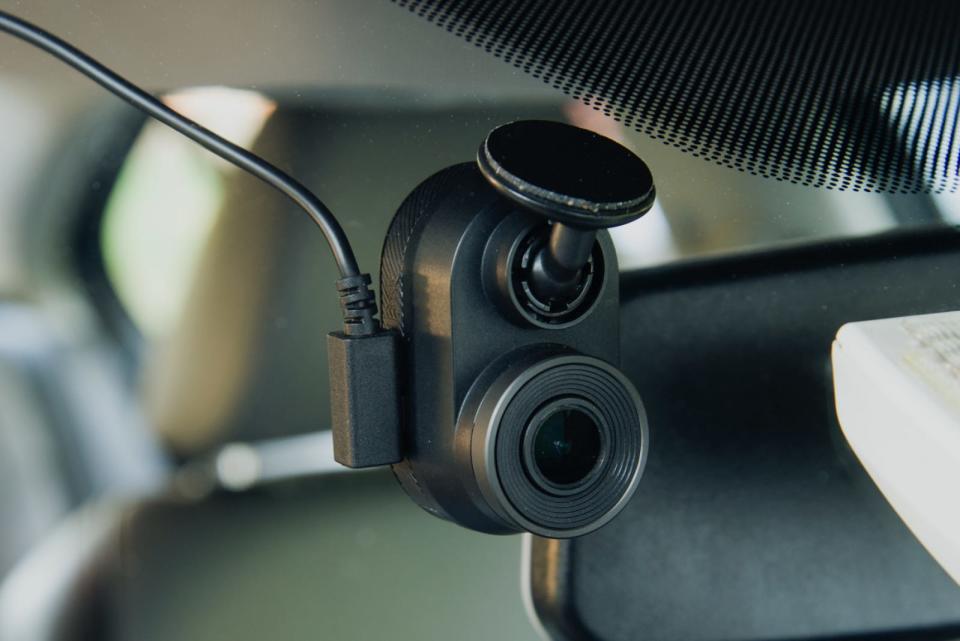
If you're looking for a dash cam that people aren't likely to notice, we recommend the Garmin Dash Cam Mini. Measuring only about 2 inches high and 1¼ inches wide (about the size of a key fob), it's one of the smallest and most discreet models we've tested, virtually disappearing on the windshield.
The Mini records at 1080p resolution, yet it delivers surprisingly good video quality compared with similar models. It has the same 140-degree FOV as the Nextbase models. In our testing, with the Mini it was harder to read license plates on parked and oncoming cars than with the best 1440p models, but the images have bright colors and good dynamic range. In night video, headlights and other bright lights don't have a lot of glare (which can't be said for many dash cams' night video), and middle tones are well rendered.

Because it comes in such a small package, the Mini doesn't have a display; you have to use the Garmin Drive smartphone app to aim the device correctly (through its live-view function) and to adjust settings. There are also only two physical buttons on the Mini's body; an easy-to-reach video-lock button is located on the back of the unit, and a button on the left side turns the audio on and off or (with a long press) formats the SD card. Since there's no physical power button, the only way to turn off the cam is to turn off the car or unplug the power cord.
The Mini's adhesive mount provides a wide range of adjustment, and you can easily pop the device on and off of it, but this mount doesn't include the handy magnetic attachment that other Garmin models have. The Garmin Drive app is more limited than the Nextbase app, and the recorded video was a bit choppy when we played it back.
Also great: Vantrue T2
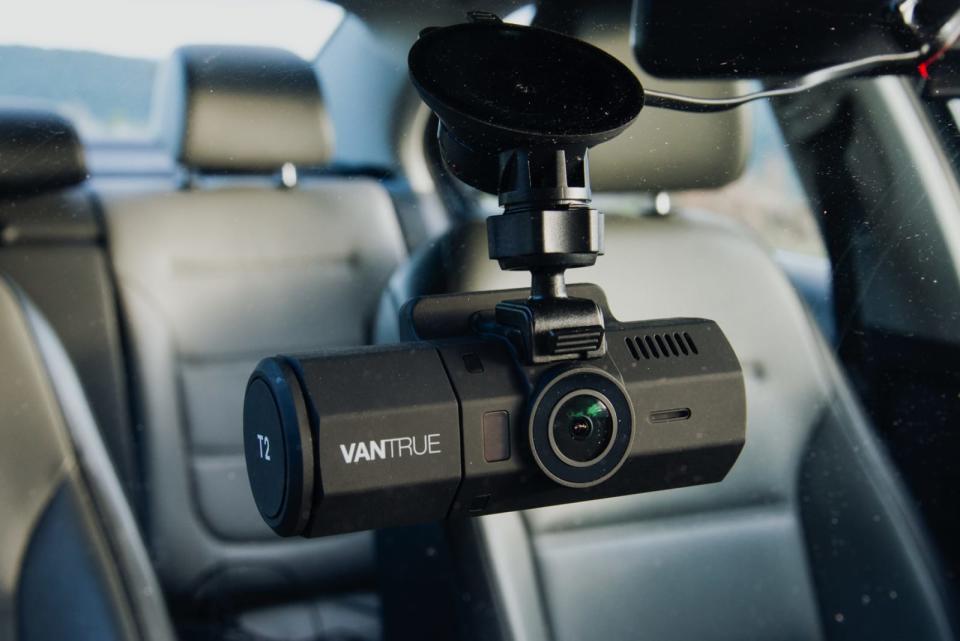
In our testing, we've run a couple of Nextbase models through several months of hot-weather use (including multiple heat waves) in Los Angeles and New York, and we haven't had any heat-related problems. But some readers, particularly those from the Southwest, southern Texas, and Florida, have asked about dash-cam models with a capacitor power supply, which generally handles temperature extremes better than a lithium battery. For these people, we recommend the Vantrue T2, which has the widest operating-temperature range (-4 to 158 degrees Fahrenheit) of any moderately priced model we've tested. (The Blackvue DR900S-1CH 4K provides the same temperature range, as well as better video quality, but it costs about twice as much.)
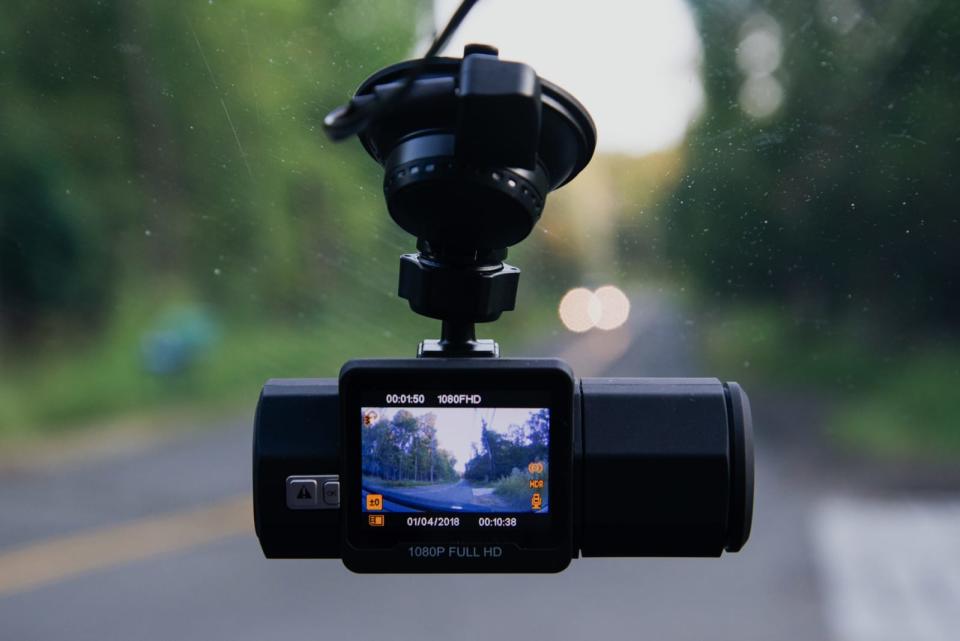
The T2 records at 1080p resolution and provides a decent image, although it's not as sharp and the colors aren't as saturated as in the Nextbase 522GW's and 422GW's video. It was harder to read license plates unless a car was right in front of us, and we saw more contrast and glare in night video.
The T2's buttons are small, but the video-lock and record buttons are clearly labeled and located on the left side, nearer to the driver. This model doesn't have a compatible phone app, and a GPS receiver is optional. The T2 does have a more sophisticated parking-mode system than most other models, though—it can detect movement in front of the car, in addition to physical bumps. To access power when the car is turned off, the T2 plugs into a vehicle's OBD-II diagnostic port (usually located near the driver's seat) instead of into the 12 V DC outlet as most dash cams do.
Also great: Owlcam

If you're seeking 24-hour surveillance for your car (whether it's parked or if someone else is driving it), get the Owlcam. Through an app and an LTE connection, this model can show live or recorded video, and it sends alerts if an incident occurs. But the Owlcam is relatively expensive at this writing, and after a free first year, the LTE service costs $10 per month or nearly $100 per year.
The Owlcam's two cameras record the front of the vehicle and the interior. If the Owlcam detects the sound of glass breaking, it illuminates the interior, begins recording, and uploads the video. If the device is stolen, you'll still be able to see the video (and the company will replace the unit free of charge with proof of the incident).
The Owlcam records in a sharp, 1440p resolution in front and an adequate 720p in the rear. The large, clear 2.4-inch touchscreen can display the front-camera and rear-camera views simultaneously, or you can turn the rear camera off. The Owlcam is quick to set up, and it easily snaps onto a secure magnetic mount.
For power when the car is turned off, the Owlcam plugs into a vehicle's OBD-II diagnostic port (often located under the dash, close to the steering wheel). The Owlcam monitors the car and sends alerts for up to 72 hours, and if it detects that the car's battery is getting low, it goes into a low-power standby mode.
To save a section of video while you're driving, you can either touch the screen or say "Okay, Presto." You can review video via the app, and the company says unsaved video lasts for about 14 days before it's overwritten. (The Owlcam is unusual in that it doesn't record to a microSD card; this prevents a thief from being able to view your video.) The app also tracks your car's location on a map and can adjust the device's settings. Like the Nextbase 522GW and 422GW, the Owlcam also includes a 911 Assist service, which has agents contact you (or call 911) after a strong impact and allows them to send emergency aid to your car's location.
What to look forward to
For our next update, we'll be looking at the latest high-resolution models from several brands. We'll check out the growing number of dual-cam models that record a vehicle's interior. And we'll be testing some additional capacitor-equipped models, for drivers who want extra insurance in extreme temperatures.
The competition
Single-cam models
The Garmin Dash Cam 56, which is the successor to our previous top pick, the Garmin 55, performed very well in our testing. Its 1440p video, with a 140-degree FOV, was almost as sharp as that of the Nextbase 522GW and 422GW, and it had good overall color and night imagery, although not quite as crisp as that of the Nextbase models. Measuring only 2¼ by 1½ inches, it's a compact dash cam so it doesn't draw attention to itself. The 56's controls aren't as easy to use as the Nextbase's touchscreens, but voice control can help with some basic functions, such as manually saving a section of video. Like the Nextbase models, the 56 uses a magnetic mount (attached to the windshield with adhesive), which makes it easy to pop on and off, but you do have to plug in or unplug the cord each time.
The Garmin Dash Cam 66W is virtually identical to the Garmin 56, except it has a super-wide, 180-degree FOV. This captures more of the scene in front of the car, but it makes things look farther away, so details are harder to see. We also noticed that the 66W's wide-angle lens made it seem as if there were more room between our car and one in front. So when a driver cut in front of us on the highway, the video didn't look as much like the close call that it actually was.
Our previous top pick, the 1440p Garmin Dash Cam 55, and its wider-angle sibling, the 1080p Garmin Dash Cam 65W (with a 180-degree FOV), have been discontinued, but they are still available from some retailers at discounted prices. Their controls, dimensions, and windshield mounts are the same as those on the Garmin 56 and 66W, above.
The Nextbase 322GW is very similar to the Nextbase 422GW, but it records in 1080p video instead of 1440p, and it doesn't work with Amazon's Alexa app. The 322GW's video is very good, but not quite as crisp as that of its more expensive siblings. Still, if you want Nextbase features and ease of use at a lower price, this model is worth considering. For tight budgets, the Nextbase 222 is an even less expensive, barebones version of the 322GW, with no connectivity features.
With its 1296p resolution, the image quality of the Papago GoSafe 550, our previous budget pick, is sharper than that of many models we've tested. It has a bright, 2.7-inch display, and its controls are reasonably easy to use, although the video-lock button is in the unit's upper-right corner, farther from the driver. The 550 is also fairly basic, without a GPS receiver, Wi-Fi, or a compatible smartphone app.
Anker's Roav DashCam C1 Pro is a budget model with 1080p resolution and built-in Wi-Fi. But even though its footage was fairly sharp and had good color, there was also a lot of video noise. And in footage taken at night, a high level of contrast produced glare in lit areas and a lack of detail in darker ones.
The Rexing V1 Gen 3 records at 2160p (4K) resolution, but its 24 frames per second isn't as smooth as the usual 30 fps, and the video, with muted colors and excessive glare, wasn't as crisp as the Nextbase 522GW's and 422GW's. In night video, the footage was contrasty and grainy. We also found it hard to adjust the lens position or connect the app.
The Vantrue X3's 1440p video wasn't as crisp as that of the 1440p Nextbase 522GW and 422GW, and its night video had a lot of contrast. The buttons on the rear are easy to access, but the labeling is difficult to read. And though the power cord connects directly to the mount, the camera doesn't slide in and out of the mount smoothly. Also, the app is basic, and we had trouble connecting it to the X3.
The GEKO S200 Starlit wasn't as sharp as you might expect, considering its 1296p resolution. This compact unit has a cheap, plasticky feel, with small buttons that tend to wiggle when pressed, and a black-on-black design with minimal labeling that's hard to read at a glance. The S200 lacks GPS, Wi-Fi, and a smartphone app.
The Thinkware X350 is an older model with worse video quality than that of our picks, and its optional plug-in GPS receiver is less convenient. It uses a capacitor instead of a lithium-ion battery.
The Rexing V1, one of the least expensive dash cams we tested, has a 1080p max resolution and a wide, 170-degree field of view. In our tests, the V1's video was not as good as that of our picks, with too much contrast, especially at night.
The inexpensive Papago GoSafe 228 had the worst image quality of any model we've tested and a fairly narrow, 120-degree FOV.
Dual-cam models
The BlackVue DR900S-2CH has a super-high, 2160p (4K) resolution that delivers excellent sharpness and wide dynamic range. The front and rear cameras both shoot very good night video, but we also saw more glare than in the Nextbase models' video. The unit has no display and minimal physical controls, so all settings—even camera alignment—require an app, which had connection issues in our tests.
BlackVue's DR490L-2CH is one of the better dual-camera models we tested, and its 3½-inch touchscreen, with large on-screen buttons, is easy to operate. The dealbreaker: There's no video-lock button to manually save footage. The mount also has no side-to-side adjustment, limiting your ability to precisely aim the camera where you want.
Cobra's DASH2316D can link to Cobra's iRadar app to alert you to the locations of speed and red-light cameras, as well as live police locations. But the 1080p front video lacked sharpness and was too contrasty, which we found resulted in too much glare at night and a lack of detail in darker areas. The 720p rear camera's video was worse. The 2316D runs on a capacitor for extra insurance in extreme temperatures. It also includes forward-collision and lane-departure alerts, but we found them to be annoyingly sensitive and switched them off.
We found the video quality of the Rexing V1P Gen 3 to be average, with a lot of contrast and excessive glare. Its buttons illuminate when pressed, but unless you touch one, they're invisible at night. You can adjust the lens in any direction by physically moving it, but this is difficult when the unit is mounted on the windshield.
Designed to record a vehicle's interior, the Rexing V2 lacks infrared LEDs, so its night interior video is almost totally black without ambient light. The cameras rotate about 180 degrees vertically, but not side to side, so it's hard to get both aligned properly. The V2 is about 5 inches wide by 3½ inches high, so it takes up a lot of real estate on the windshield.
The Papago GoSafe S780's rear camera mounts on the rear window (to record behind the car) or on the windshield (to record the interior). But its rear camera is only so-so, and if there's no ambient light, the interior image is almost totally black. We had a difficult time tightening the mount's plastic locking nut without the cam going crooked.
The Papago GoSafe 760 doesn't stand out against its competitors, with weaker video, especially at night, from the 1080p front and rear cameras. The rear camera has a narrow, 120-degree field of view, and in our tests at night it lacked detail in darker areas, with glare that made license plates hard to read.
The BlackVue DR490-2CH's front and rear cams provided good contrast and dynamic range, and its capacitor power supply adds reliability in extreme temperatures. But it lacks a display, and without Wi-Fi or a smartphone app, you must play all footage back on a computer.
The Transcend DrivePro 520 can record a car's interior, but the rear camera has a very narrow, 110-degree field of view, and we found that seeing people in the rear seat at night was harder than with the Vantrue N2 Pro.
Multifunction models
The PureGear PureCam offers many of the same features as the Owlcam, including 24-hour monitoring, live streaming through a smartphone app, and dual cameras that record a vehicle's front view and interior. The PureCam also provides a hotspot for connecting up to three devices. This camera connects through a car's OBD-II port for continuous power in parking mode, and it requires a data plan for the full services. The 1080p front cam provided reasonably sharp video in our tests, but it was very dark out of the box, and night video was grainy. The 4-inch display was easy to view. But the PureCam is a large device, and we had difficulty finding a location on the windshield where we could properly aim both cameras without the device being too prominent. We also found its small buttons hard to navigate; they're positioned on the right side, out of the driver's sight, and have no tactile feel.
The Cobra Road Scout is basically a radar detector with an integrated dash cam. With 1080p resolution and a reasonable 154-degree FOV, the Road Scout captures decent video, although it's not as sharp as that of the 1440p Nextbase and Garmin models we tested. A strong magnetic mount makes it easy to pop the Scout on and off the windshield. But at about 4 by 4 inches, the Road Scout is large by dash-cam standards, and it's one of the most expensive models we've tested. You also can't review video on its small radar-detector display; you have to use the phone app. Still, the Road Scout could be a good choice if you want the advantages of a radar detector and a dash cam, but you don't want separate devices on your dash.
The Garmin Speak Plus is a unique, voice-activated device that includes a 1080p dash cam, Garmin navigation, and Amazon's Alexa capability. It's effective for navigation, but if you primarily want a dash cam, there are better choices. It has a very narrow, 82-degree field of view, the compact display does not show dash-cam video, and the unit needs to pair to your phone via Bluetooth to function at all.
The Waylens Secure360 monitors a parked vehicle, and like the Owlcam, its LTE connection saves video of incidents (or shows live video) on its app (iOS, Android). (The Wi-Fi version records to a microSD card.) Its 360-degree lens records in front of the car and in the interior, but in our tests its ultra-wide-angle view made details hard to see. It also lacks a display and requires that you purchase a data plan. The more expensive, 4K version can plug into a car's OBD-II port for continuous power, but the standard version needs to be hardwired into a car's fuse box.
The Klashwerks Raven combines a dual-cam setup with navigation, security, and vehicle tracking. But it's hard to get both cameras aligned, and it's difficult to consistently save video using this model's gesture controls. In hot weather, the adhesive mount had trouble holding the large, 7-inch device on our windshield. We tested an early unit (in the summer of 2018), and Klashwerks has released a number of updates since our test, so we may take another look at it in the future.
How to set up a dash cam
To get the best view of the road ahead, mount a dash cam high in the center of the windshield, near the rearview mirror. You want to be able to see the unit's screen and easily reach its controls, but you don't want a camera to block your forward view. Some states have regulations about what can be mounted on a windshield and where, so check your local laws.
Most dash cams have a long cord that plugs into a car's 12 V DC outlet (also known as a cigarette lighter). To get the unit's dangling cord out of your way, we suggest running it to the passenger side and tucking it into the molding between the top of the windshield and the car's headliner. From there, you can run the cord down along the edge of the windshield and the front pillar, into the gap on the side of the dash, and underneath the dash to the power outlet. It's not hard to do, but getting the cord secured can require patience. Some models include small cable-holding clips that adhere to the glass and hold the cord, as well as a small tool for fitting the cord between the trim or molding. This video does a decent job of showing how to perform a tidy installation.
If you can't give up your car's only 12 V connection to power a dash cam, you have a couple of options. If the power cord unplugs from its adapter, you could plug it into a multiport USB car charger, which leaves a port open for other devices. If not, you could use a 12-volt splitter; in our testing, we had success with these three-outlet splitters. Most dash-cam companies also sell hardwire kits that can connect directly to a vehicle's fuse box. In fact, this is often the best way to get reliable power for using a model's parking mode. If you're comfortable with doing basic automotive wiring and using a circuit tester, you can easily hardwire the cam to the fuse box yourself. But any car stereo shop can also do this for you.
This guide may have been updated by Wirecutter. To see the current recommendation, please go here.
When readers choose to buy Wirecutter's independently chosen editorial picks, Wirecutter and Engadget may earn affiliate commissions.
